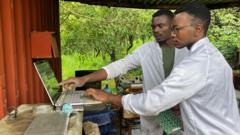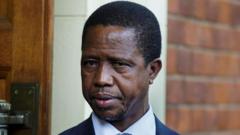In Zambia, a bitcoin mine powered by hydroelectric energy transforms local economics, providing cheap electricity and fostering community growth while tackling the challenges associated with cryptocurrency mining.**
Harnessing Nature: Renewable Energy Powers Bitcoin Mining in Zambia**

Harnessing Nature: Renewable Energy Powers Bitcoin Mining in Zambia**
A revolutionary bitcoin mine in Zambia uses hydroelectric power to create clean energy solutions while benefiting the local community.**
The roar of the Zambezi River echoes through the Zambian wilderness, mingling with the high-pitched whirr of computers working tirelessly in a remote bitcoin mine. Here, in the far northwestern reaches of Zambia near the DRC border, a visionary approach to cryptocurrency mining is taking root, combining the power of renewable energy with the potential for economic uplift.
Phillip Walton of Gridless oversees a bitcoin mining operation set up inside a shipping container that houses 120 computers, all of which are using the river's hydro-electric power for their operations. This unique location allows Gridless to tap into the abundant, clean energy generated by a hydroelectric plant fed by the Zambezi River. The cost-effectiveness of this power source makes mining profitable even when bitcoin prices fluctuate. "With our partnership, we significantly reduce operational costs while providing a boost to the local power economy," says Walton.
The Zengamina hydro-power plant, established in the early 2000s with community fundraising, had struggled to remain viable. The partnership with bitcoin mining has been instrumental in transforming the plant's finances, reducing waste and enhancing revenue streams. Now contributing approximately 30% of the plant's income, the bitcoin mine has allowed it to provide affordable electricity for the local community of around 15,000 people.
Residents of Zengamina have experienced a profound change since the advent of electricity. Barbershop owner Damian, whose business flourishes thanks to the power supply, states, "Electricity has changed my life." His story is echoed by local youth who can now communicate and enjoy entertainment – luxuries that were previously unimaginable.
While the locals may not understand the complexities of cryptocurrency mining, they feel the positive ripple effects. Plans to expand infrastructure and connect to a national grid highlight growth on the horizon, indicating a sustainable future for the community and new ventures for Gridless. However, challenges remain; the growing demand for power raises concerns about the environmental implications of bitcoin mining.
Despite skepticism from those who view bitcoin as a self-serving burden on energy resources, Gridless aims to establish more hydroelectric plants to further support rural electrification while utilizing surplus power to mine cryptocurrencies. Co-founder Janet Maingi emphasizes the importance of sustainable, consumer-adapted power systems for African communities, reiterating a commitment to local interests over solely profit.
Historically, there have been global struggles surrounding the impact of high-energy consumption in bitcoin mining, but cases like Zengamina show a model for combining cryptocurrency with renewable resources. As the industry evolves, it becomes clear that innovative partnerships can yield benefits beyond digital currency, offering clean energy access and economic empowerment to underserved communities.
Phillip Walton of Gridless oversees a bitcoin mining operation set up inside a shipping container that houses 120 computers, all of which are using the river's hydro-electric power for their operations. This unique location allows Gridless to tap into the abundant, clean energy generated by a hydroelectric plant fed by the Zambezi River. The cost-effectiveness of this power source makes mining profitable even when bitcoin prices fluctuate. "With our partnership, we significantly reduce operational costs while providing a boost to the local power economy," says Walton.
The Zengamina hydro-power plant, established in the early 2000s with community fundraising, had struggled to remain viable. The partnership with bitcoin mining has been instrumental in transforming the plant's finances, reducing waste and enhancing revenue streams. Now contributing approximately 30% of the plant's income, the bitcoin mine has allowed it to provide affordable electricity for the local community of around 15,000 people.
Residents of Zengamina have experienced a profound change since the advent of electricity. Barbershop owner Damian, whose business flourishes thanks to the power supply, states, "Electricity has changed my life." His story is echoed by local youth who can now communicate and enjoy entertainment – luxuries that were previously unimaginable.
While the locals may not understand the complexities of cryptocurrency mining, they feel the positive ripple effects. Plans to expand infrastructure and connect to a national grid highlight growth on the horizon, indicating a sustainable future for the community and new ventures for Gridless. However, challenges remain; the growing demand for power raises concerns about the environmental implications of bitcoin mining.
Despite skepticism from those who view bitcoin as a self-serving burden on energy resources, Gridless aims to establish more hydroelectric plants to further support rural electrification while utilizing surplus power to mine cryptocurrencies. Co-founder Janet Maingi emphasizes the importance of sustainable, consumer-adapted power systems for African communities, reiterating a commitment to local interests over solely profit.
Historically, there have been global struggles surrounding the impact of high-energy consumption in bitcoin mining, but cases like Zengamina show a model for combining cryptocurrency with renewable resources. As the industry evolves, it becomes clear that innovative partnerships can yield benefits beyond digital currency, offering clean energy access and economic empowerment to underserved communities.





















